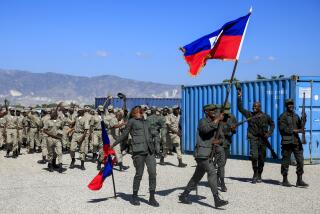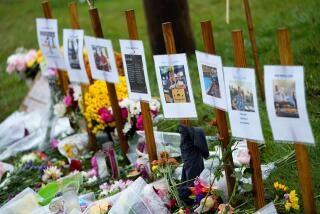Haitian Army Pronounced Dead as Arm of Repression : Caribbean: With its top leaders out, debate begins on how to restructure it. Some question whether the nation needs a full-fledged military.
- Share via
PORT-AU-PRINCE, Haiti — For all intents and purposes, Haiti’s army, an instrument of corruption and repression by tyrants and dictators across nearly two centuries, no longer exists, according to U.S. officials and military officers.
“It died yesterday. It is a corpse, it just hasn’t been buried yet. That comes Saturday,” said a senior U.S. army officer.
He spoke of the resignation Monday of former Commander in Chief Lt. Gen. Raoul Cedras and his chief aide, Brig. Gen. Philippe Biamby, and this Saturday’s restoration of Jean-Bertrand Aristide as president.
Cedras, Biamby and police chief Lt. Col. Michel-Joseph Francois had ruled Haiti with vengeance and greed for more than three years since Aristide was driven into exile by a military coup.
But with American patience exhausted and President Clinton embarrassed by the Haitian army’s refusal to give in to traditional pressure and threats, American troops put an effective end to the troika Sept. 19.
It was never much of an army anyway. Although its current version is a mutant child of a national guard created by U.S. Marines during their 1915-1934 occupation of Haiti, its mission was never a traditional military one.
“From the beginning,” said a Haitian expert, “the army was designed to maintain order and protect the ruling elite and its property against popular movements.
“By the time Aristide was elected (in 1990), it had degraded even from the original goal and was nothing more than self-serving killers and thieves.”
Led by men virtually more experienced in extortion than battle, equipped with weapons more useful to a gun museum than a fighting force and less trained than an American high-school ROTC unit, the armed forces of Haiti couldn’t even march in step.
“It is an embarrassment,” a French officer said in 1991 while watching Cedras lead his stumbling forces through a Military Day parade. “I have tin soldiers who march better than that.”
The occupation also ended the entire concept of a Haitian army as it has been understood since Haitian slaves formed a military and drove out their French masters in 1804.
Since that year, a Haitian political expert said, the army, whether on its own or as the instrument of some class or another, became an institution that preceded all other institutions, according to Haitian experts.
“It represented independence and sovereignty for Haiti,” said one former Haitian diplomat. “But in reality it ran this country without regard for any interests but its own. It was always more a feudal group of thugs than a real military institution.”
“This army, if you can call it that, had a monopoly on violence and there was no counterweight,” agreed a U.S. official. “It terrorized the people into cowardice, and it killed or corrupted anyone that could oppose it.”
That is over now, the sources concluded. “The resignations (of the three leaders) are just the start,” said a U.S. official. “Many of the rest of the officers will either quit or be purged, and the entire institution will be reformed and reduced to a relative handful.”
The bloody role of the Haitian military right up to Sept. 19 raises questions in the minds of many Haitians, including some of Aristide’s closest advisers, about the need for an army.
“I know we need police,” said Franz Voltaire, an Aristide supporter and aide to acting Prime Minister Robert Malval. “But police will be armed only with pistols and side arms, not M-16s (assault rifles) and Uzis (submachine guns).
“Costa Rica doesn’t have any army and it gets along OK. Let’s just remove the temptation for future abuse.”
Privately, many U.S. officials agree. But American policy continues to reflect a debate between traditional U.S. military concern for maintaining a conservative institution to offset regional instability and foreign-service experts who think that a small nation’s economy and political structure should preclude a serious military Establishment.
Alluding to Haiti’s border with the Dominican Republic and its long coastline as requiring some sort of defense force, U.S. Embassy spokesman Stanley Schrager gave the prevailing American view recently: “Our hope is to preserve the army as an institution . . . a smaller one and a more professional one.
“Besides,” he continued, “there is the iconography of the institution. Countries think they need an army” as a symbol of nationhood.
The army officially has 7,000 soldiers, including 1,500 police, a figure that Aristide wants cut to about 1,500. U.S. sources say the total more likely will be about 3,000.
The purging is well under way. U.S. officers estimate that more than half of the soldiers have deserted and more are leaving. American troops have confiscated nearly every usable weapon, and all important orders are issued by U.S. commanders.
“Cedras’ military had four generals,” said a military planner. “For the new one, a colonel would probably do, but it may have one general for appearances’ sake.”
More to Read
Sign up for Essential California
The most important California stories and recommendations in your inbox every morning.
You may occasionally receive promotional content from the Los Angeles Times.










